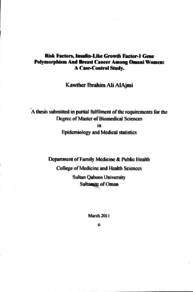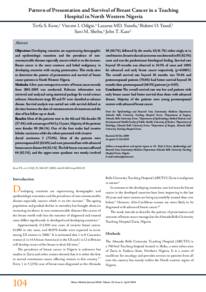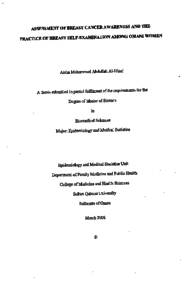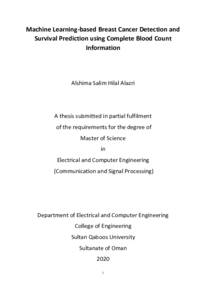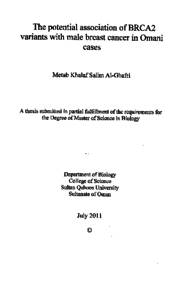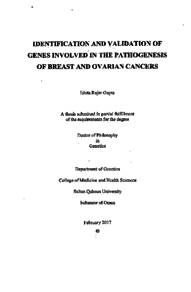Document
Risk factors, insulin-like growth factor-I gene polymorphism and breast cancer among Omani women : a case-control study
Publisher
Sultan Qaboos University
Gregorian
2011
Language
English
English abstract
Breast cancer is the most common cancer among females worldwide and it is responsible for 370,000 deaths annually. The incidence rate of breast cancer is increasing while the mortality rate is decreasing. The burden of this cancer is rising with increasing recognition of many risk factors. This study evaluated lifestyle and reproductive risk factors and their relationship with breast cancer risk in the Sultanate of Oman. It also investigated the role of IGF1 CA repeats gene polymorphism with the risk of breast cancer among Omani women. A case control study was conducted using 174 Omani females with breast cancer either newly diagnosed or old cases from SQUH and Royal Hospital, and 149 Omani female without any history of any type of cancer which served as controls. A pretested Questionnaire was used to assess the risk factors and blood samples were collected to investigate the IGF1 CA repeats polymorphism. Using univariate and multivariate logistic regression analysis method; Age, Occupation, Family Income, Family History of breast cancer, use of contraceptives and duration of contraceptives use appeared to be associated with the development of breast cancer among Omani women. Breast cancer among Omani females presents at advanced stage and at younger age as compared to Western countries. In case of IGF1 CA repeats, CA 19 was the most frequent genotype among both cases and controls followed by CA 18. The overall distribution of CA genotypes was significantly different between cases and controls (P value = 0.022) and was observed among premenopausal women (P value = 0.003) while among postmenopausal the distribution was not significantly different (P value = 0.429). Odds Ratios and 95% CI for IGF1 genotype groups showed that there was no significant association between breast cancer and CA 19 either among pre or postmenopausal women even after adjusting the strongest risk factors of breast cancer. However, there was a significant association between breast cancer and both progesterone receptor status and type of the cancer. In conclusion, even though the incidence of breast cancer in Oman is low. It is increasing. More concern should be taken in increasing the awareness of breast cancer especially the most significant risk factors among Omani women.
Member of
Resource URL
Arabic abstract
يعتبر سرطان الثدي من أكثر أنواع السرطان شيوعا بين النساء في جميع أنحاء العالم وهو المسؤول تقريبا عن 370000 حالة وفاة سنويا. معدل الإصابة وعبء سرطان الثدي يزداد في حين أن معدل وفيات آخذ في التناقص اسباب هذا المرض غير معروفة ولكن هناك العديد من عوامل الخطورة المرتبطة بتطور هذا السرطان. الهدف من هذه الدراسة هو تقييم مدى ارتباط سرطان الثدي بنمط الحياة وعوامل الخطورة الإنجابية بين النساء العمانيات. كذلك فنحن نحقق في دور هرمون IGF1 وخصوصا منطقة السيتوسين أدنين الموجودة في الجين المسوؤل عن هذا الهرمون وعلاقتها بالإصابة بسرطان الثدي بين النساء العمانيات. التحقيق أهداف الدراسة قمنا بجمع معلومات وسحب عينات دم من 174 مصابة بسرطان الثدي من مستشفى جامعة السلطان قابوس والمستشفى السلطاني سواء كانت المريضة تم تشخيصها حديثا أو قد بدأت في العلاج. وجمعنا 149 عينة من الإناث العماني والتي يشترط فيها عدم التشخيص بأي نوع من أنواع السرطانات في أي مرحلة من حياتها. استخدم الإستبيان لتقييم عوامل الخطورة وأخذت عينات دم لعمل الفحوصات الجينية لتقييم علاقة هرمون IGF1 بسرطان الثدي. وبعد مرحلة جمع العينات والمعلومات بدأ التحليل الإحصائي لاستخلاص النتائج واستخدم التحليل اللوجستي التحوفي وحيد المتغير و المتعدد المتغيرات واختبار مربع کاي. فكانت النتائج أن العمر والمهنة ودخل الأسرة ، التاريخ العائلي لسرطان الثدي ، واستخدام وسائل منع الحمل ومدة استخدام هذه الموانع تترافق مع تطور سرطان الثدي بين النساء العمانيات. وتبين أيضا أن المرض يظهر في مرحلة متقدمة وفي سن أصغر مقارنة مع الدول الغربية. بالنسبة للهدف الأخير فقد تبين أن النمط الوراثي الأكثر شيوعا هو تعدد السيتوسين والأدنين 19 ويليه 18. وتبين أيضا أن التوزع الجيني للتعدد يختلف اختلافا كبيرا بين الحالات والضوابط (نسبة الخطأ =0 . 022) ويظهر هذا الاختلاف بين النساء قبل سن اليأس (نسبة الخطأ = 0. 003) ، أما في حالة بعد سن اليأس نسبة الخطأ = 0 . 429) مما يؤكد عدم وجود اختلاف ملحوظ بين هذه الفئة. بعد حساب نسب الأرجحية و مدى الثقة 95 % للمجموعات الوراثية للهرمون IGF1 ، توضح أن ليس هناك علاقة كبيرة بين سرطان الثدي والتعدد 19 بين جميع الفئات ومع الأخذ في الحسبان أقوى عوامل الخطر للإصابة بسرطان الثدي. ومع ذلك ، كان هناك ارتباط مهم بین سرطان الثدي ونوع سرطان الثدي و أيضا ارتباط مهم مع حالة مستقبل هرمون البروجستيرون. وختاما ، على الرغم من أن معدل الإصابة بسرطان الثدي في عمان منخفض لكنه أخذ في الازدياد. وينبغي اتخاذ المزيد من الاهتمام من خلال زيادة الوعي بسرطان الثدي وخاصة عوامل الخطورة الأكثر أهمية بين النساء العمانيات.
Category
Theses and Dissertations

